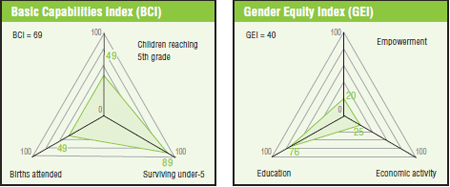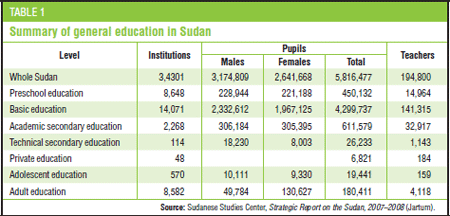Two countries, more challenges
National Civic Forum
Mdani Abbas Medani
Afaf Awad
The secession of South Sudan will have severe impacts on both the northern and southern States. Development plans in North Sudan will be seriously at risk due to its dependence on oil revenues, while South Sudan faces major economic and social hardships that could turn the new country into a failed state. Although some gender indicators have improved, there is still a long way to go to bridge the gap between women and men, especially since bias against women is deeply rooted in society. The signing of the Comprehensive Peace Agreement in 2005 paved the way for civil society organizations to play an effective role in monitoring elections and referendums and to establish parliamentary watch groups.
 |
2010 marked a turning point in Sudan’s political history. Presidential and parliamentary elections were held and preparations were made for the South Sudan Independence Referendum, which included taking of a census in order to determine the nature and number of the electorate. The referendum took place from 9-15 January 2011 and the results, published on 7 February, showed that 98% of voters were in favour of independence. As a result, it was agreed that the Republic of South Sudan would be officially declared a new sovereign State in July of the same year.
According to a survey on poverty conducted in 2009, 46.5% of the Sudanese population currently lives below the poverty line.[1] Critical issues include conflict, displacement and food insecurity, to which major contributing factors are natural and partly human-made disasters such as drought, desertification and floods.[2]
A brief history of the civil conflicts
Sudan has faced two great civil wars since independence, the first between 1955 and 1972 and the second (considered a prolongation of the first) between 1983 and 2005. The roots of the conflicts can be traced back to colonial times when the British established separate administrations for the northern part, which was more akin to Islamic Egypt, and the southern part, which was similar to Kenya and Tanganyika (now Tanzania). The independence process took place without the participation of emissaries from the south, so their demands and needs were not considered. This led to the First Sudanese Civil War, which started after the Government attacked southern protesters and political dissidents, bringing about increased violence and mutinies that transitioned into a full-scale war. This phase of the conflicts ended with the Addis Ababa Accord, which was meant to grant the south a good deal of autonomy.
The terms of the agreement were not fully implemented, however, and so the Second Civil War broke out. This was officially ended with the signing of the Comprehensive Peace Agreement (CPA) in 2005 between the ruling National Congress Party (NCP) and Sudan People’s Liberation Movement (SPLM). In its aftermath the South Sudan Independence Referendum was proposed.
Environmental challenges
The Sudanese territory faces some critical environmental challenges, including soil erosion, land degradation, deforestation and desertification, which threaten prospects for lasting peace and sustainable development. Expanding settlements, for example, have already compromised the country’s forests. Almost 75% of its energy supply is provided by traditional fuels such as wood, which (in addition to the demand for charcoal) has led to the clearing of many forests. This is speeding the process of desertification as the Sahara advances onto previously arable and forested land.[3] The United Nations Environment Programme (UNEP) has also identified two other major causes of desertification: climate-based conversion of semi-desert to desert; and degradation of existing desert environments, including wadis and oases, through human activity.[4]
Although the Government designated nearly 4% of the land as protected areas, there is still severe poaching, threatening animal populations throughout the country. Many conservation efforts were jeopardized by the civil conflicts, especially since military forces took control of ecologically rich woodlands in South Sudan.[5] According to the UNDP, there are clear linkages between environmental problems and the wars that have afflicted the country: “Competition over oil and gas reserves, Nile waters and timber, as well as land use issues related to agricultural land, are important causative factors in the instigation and perpetuation of conflict in Sudan. Confrontations over rangeland and rain-fed agricultural land in the drier parts of the country are a particularly striking manifestation of the connection between natural resource scarcity and violent conflict.”[6]
Despite serious water shortages, flooding is common – both flash floods caused by heavy rains and more widespread floods caused by the overflow of the Nile and its tributaries – and results in widespread damage, including riverbank erosion and the corresponding loss of crops.[7]
Fresh challenges for the two Sudans
 |
North Sudan and South Sudan have been discussing pending issues such as border demarcation, especially concerning the oil-rich Abyei region, which by 2003 contributed more than a quarter of the country’s total crude oil output, although production volumes have declined since and some reports suggest that the region’s reserves are nearing depletion.[8] A referendum was planned to decide whether Abyei would be part of the Bahr El Ghazal region of South Sudan or the South Kordofan region of North Sudan. Originally, it was intended to hold this referendum simultaneously with the independence referendum, but it had to be postponed due to severe disagreements over the process, and violence has escalated since then.
The economy of North Sudan, highly dependent on oil revenues, will be negatively affected by the secession, while the South will face several obstacles in its path to establishing itself as a viable State. For example, despite the fact that the southern territory holds three quarters of the oil production sites, nearly all of the refineries and pipelines are in the north. In addition, the question of nationality and integration remains open. Will the Government in South Sudan be able to forge a national identity uniting the peoples inhabiting its territory, which are among the most linguistically and culturally diverse in the world? Even greater challenges for South Sudan are poverty, lack of access to healthcare and rampant maternal and child mortality.[9]
Gender inequality
Female enrolment in primary education increased from 64.4% during 2006–2007 to 69.9% in 2009, while female enrolment in secondary education increased from 30% in 2005 to 35.5% in 2009.[10] In addition, Sudanese women have made some progress in terms of representation and political participation: in the 2010 elections women won 28% of parliamentary seats.
Despite this encouraging data, however, there is still great inequality when it comes to women’s chances of being promoted to higher positions and also getting access to training opportunities and most of the activities run by Sudanese women are in agriculture and the informal sector. Also, due mostly to the armed conflicts and civil wars, Sudanese women have been suffering from the lack of basic services, especially healthcare. Maternal mortality, for example, stands at 509 per 100,000 live births.[11] In addition, social and cultural norms, beliefs and traditional practices continue to hinder women from engaging actively in all walks of life.
The role of civil society
The signing of the CPA in 2005 paved the way for civil society organizations (CSOs) to engage effectively in addressing key issues, and many have been participating in monitoring Sudan’s elections and South Sudan’s referenda, observing the entire electoral process in terms of voter education, voter registration and electoral campaigning, and providing technical assistance for the training of domestic observers. Also some CSOs have started establishing parliamentary watch groups charged with monitoring the performance of parliament at State and Federal levels.
However CSOs have not engaged actively in decision-making and major policy issues. This is mostly due to their tense relationship with the Government, especially regarding restrictions on their activities.
Conclusion
Both North Sudan and South Sudan face serious developmental and environmental challenges that can only be exacerbated by continuing conflict, and agreement still needs to be reached on key issues such as oil rights, water rights and citizenship. Donor countries have urged both countries to reduce their reliance on oil, increase their food security through agricultural development, and expand health, education, water and sanitation services.[12] Stability and increased trade between north and south as well as with their neighbours would provide economic opportunities for young people, who make up more than half of the population, and for women and girls, whose educational and job opportunities have been limited to date.[13]
[1] Ministry of Welfare and Social Security and National Population Council, Sudan Millennium Development Goals Progress Report 2010, <www.sd.undp.org/doc/Sudan%20MDGs%20Report%202010.pdf>.
[2] United Nations Environment Programme (UNEP), Sudan: Post-Conflict Environmental Assessment, (Nairobi: 2007), <postconflict.unep.ch/publications/UNEP_Sudan.pdf>.
[3] Countries Quest, Sudan, Land and Resources, Environmental Issues, <www.countriesquest.com/africa/sudan/land_and_resources/environmental_issues.htm>.
[4] UNEP, op. cit.
[5] Countries Quest, op. cit.
[6] UNDP Sudan, Environment and Energy for Sustainable Development, (2011), <www.sd.undp.org/focus_environment.htm>.
[7] UNEP, op. cit.
[8] R. Hamilton, “Oil-rich Abyei: Time to Update the Shorthand for Sudan’s Flashpoint Border Town?,” Christian Science Monitor, (3 November 2010), <pulitzercenter.org/articles/oil-rich-abyei-sudan-accuracy-label>.
[9] A.Thurston, “Five Challenges South Sudan Will Face After Referendum,” Christian Science Monitor, (27 January 2011), <www.csmonitor.com>.
[10] Trading Economics, Sudan World Bank Data, (2010),<www.tradingeconomics.com/sudan/indicators>.
[11] UNICEF, Sudan Statistics, <www.unicef.org/infobycountry/sudan_statistics.html>
[12] E. Solheim, A. Mitchell and R. Shah, “Sudan at a Crossroads,” The Guardian, (7 May 2011), <www.guardian.co.uk>
[13] Ibid.


